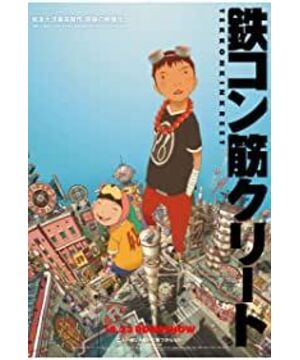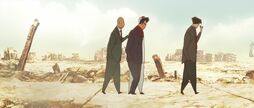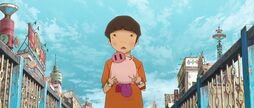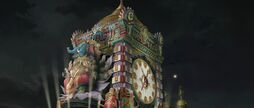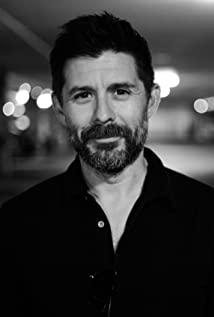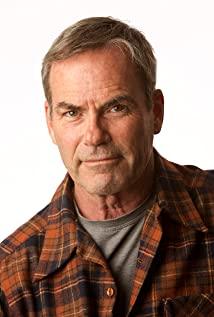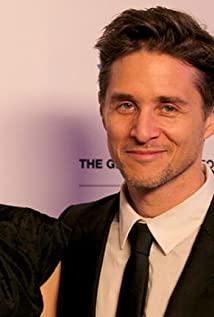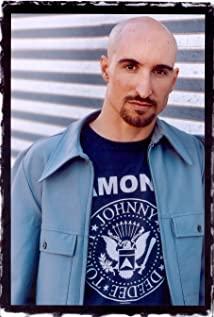Author: I won’t tell you if you die.
On April 6, 2016, there will be an exhibition of original paintings celebrating the 10th anniversary of the release of "Evil Boy" at 213 Setiyama, Miharu Town, Tamura County, Fukushima Prefecture, Japan. moon. At the same time, a crowdfunding campaign for the original collection will be held on the official website of Studio 4℃.
Evil Boy’s father and mother
mentioned "Evil Boy" (鉄コン筋クリート), the theater version released in 2006. First of all, it is natural to talk about its original manga and its original author, Matsumoto Daiyo. Matsumoto Daiyo was born in Tokyo in 1967. His mother was a poet and fairy tale writer Naoko Kudo. When he was in high school, his mother who liked comics recommended the works of Otomo Katsuhiro and Yoshida Akyu. Comics have generated interest. After that, he absorbed the characteristics of Tsuchida Seiki, Mochizuki Minetaro, Takuto Kazuo, Otomo Katsuhiro, and formed his own unique painting style. The manga "Evil Boy" was created after he jumped from Kodansha to Shogakukan, and the origin of the name is more interesting. When he was a child, Matsumoto Daiyo always used to mispronounce the Japanese reinforced concrete "鉄筋コンクリート" as "鉄筋コンクリート".コン筋クリート", because this work tells the story of the demolition of an aerial city, so the name was named "鉄コン筋クリート". When the Hong Kong Jade Dynasty Publishing House published a Chinese single-volume comic book, the title was translated into "Evil Child ".
In 1993, Matsumoto Daiyo serialized the comics of "Evil Boy" on the "Big Comic Spirits" of Shogakukan. By the end of 1994, there were always 33 chapters and 3 books. The content of the story is about two street orphans named Xiaohei and Xiaobai living in an overhead city in Treasure Town. They claim to be the protectors of the city, and they clashed with foreign forces planning to demolish and develop the city. At the same time, the police and other local forces were involved in disputes by this development plan. At the end of 1995, the American American MICHAEL ARIAS, who was the supervisor of the animation of "Evil Boy", came to work in Japan again. After being introduced by others, he saw the manga "Evil Boy". I was fascinated and became a loyal fan of Matsumoto Taiyo, and I have been hoping to visualize this manga.
Michael was born in California in the United States in 1970. Since he was a child, he has been fond of fiddling with visual effects. When he was 19 years old, he was able to join the production team of James Cameron’s film "The Abyss". In 1990, he also participated in the movie "Total Recall" starring Schwarzenegger as a photography assistant. Later, he came to Japan to work because he had taken Japanese as an elective course in college, so at least there was no problem with the language pass.
After coming to Japan, I started working in the special effects department of IMAGIC, but not long after I was recommended to the famous game company SEGA (SEGA), I participated in the production of a game there, and then returned to the United States in 1993. , Restarted film production in New York, established a computer vision company to provide special effects services for film screens, and participated in the production of The Hudsucker Proxy by the Coen Brothers, and the Butterfly by David Cronenberg Movies such as "M.Butterfly" also allowed him to accumulate a lot of contacts in the film industry. In 1995, he withdrew from the front line and joined SOFTIMAGE, focusing on the development of computer CG technology and applying it to the production of games and animation. The software "TOON SHADER" he participated in the development was favored by Ghibli. Because this software can well combine hand-painted 2D with computer 3D, it was used in Hayao Miyazaki's new work "Princess Mononoke" at that time. Everyone still remembers the scene of the Kylin God destroying the forest at the end of the film. Many of those scenes were made with this software. Later in 1998, the old club Sega officially announced the new host DreamCast (DC), the new machine can make the game's screen performance more powerful. So in the same year, Sega established a joint venture company that specializes in CG graphics. Michael entered the company again and returned to the front line.
It is precisely because of his experiences in the United States and Japan that he was chosen by the Wachowski brothers (now sisters), the director of "The Matrix", and asked him to be the producer of the animated version of "The Matrix". Specially responsible for contacting and coordinating cooperation between Japan and the United States. It has been 5 years since he first came into contact with the comics of "Evil Child" at this time. In the past 5 years, he has always wanted to put "Evil Boy" on the screen and made a trial version of the short story, but he didn't meet the right investors to make the full version. He also mentioned in the interview that he has been running back and forth between the United States and Japan in the past ten years, and his hard life has made him give up once. It is the comics of "Evil Boy" that have been inspiring him to challenge new goals and persevere. Until now.
The reason for the appearance of "The Matrix" is that the Wachowski brothers have always liked Japanese animation before. The original idea of "The Matrix" was partly inspired by the Japanese animation "Ghost in the Shell". When the first box office of "The Matrix" went viral, they became famous, and they had money in their hands. Of course, they had to satisfy their desires back then. So they spent money to let the top animation supervisors and animation companies in Japan, the United States and South Korea create "The Matrix". Two Japanese animation companies were selected, one is Madhouse, which has been established for many years, and the other is Studio 4°C, a company with its own unique style. As for why Michael would recommend this company, this is still related to "Evil Boy".
At the beginning, Michael liked "Evil Boy" very much, and thought it would be fun to make a video, so in 1995, he made a small animation of about ten seconds by himself, and this was made out of personal hobby. , Has not been authorized by the original author Matsumoto Taiyo at all. Later, when Michael met Taiyo Matsumoto, he felt a little embarrassed to mention this. Because Michael himself is good at CG production and photographic visual performance, but to make a film requires a team to work together, he said when he chatted with his colleague Hiroaki Takeuchi, if the work of "Evil Child" is made I believe the animation will be very interesting. As a result, Takeuchi Hiroaki recommended one of his friends, Kouji Morimoto at 4°C, and thought it would be appropriate to let him be the supervisor.
Under Takeuchi’s introduction, Morimoto and Michael met. In fact, not long after the comics came out, many people at 4°C Morimoto had seen this work, and they were fans of the comics. Later, because there were no suitable conditions, I have never made it into an animation. After the two fans met, it was almost too late to meet each other, and then ran to Matsumoto Taiyo to apply for the authorization to be adapted into an animation. At that time, because of the special pictures and expressions of the manga "Evil Boy", it was called by the industry as a work that was difficult to animate. After all, the mainstream of Japanese animation at that time was mainly based on 2D celluloid animation. If you want to restore this well, It’s more difficult to have an alternative style of painting. It just so happened that Morimoto had just completed a digital experimental animation "Sound Life" in 1997 that used a lot of computer production. From this work, we can see the embryonic form of digital production in the future, and this is why Morimoto felt that "Evil Child" should be well represented. For the complex scenes, 3DCG must be used.
It just so happens that Michael is good at CG. In this way, Akoji Morimoto is the supervisor and Michael is the CG production. Since 1998, he has been producing the trial version of "Evil Boy". After the production of this short film was completed, it caused a heated debate in the Japanese animation industry at the time. Because in 1995, Pixar in the United States produced a full 3DCG production of "Toy Story", announcing the debut of a new animation mode, and then 3DCG animation in the United States gradually Become the mainstream. Japan, which is a bit slow to respond and loves 2D hand-painting, mostly puts CG animation on the side of the game, and seldom wants to use pure 3DCG in animation production. Therefore, this short 4-minute short film made entirely of 3DCG, while showing the original look of "Evil Boy", is also declaring to colleagues that even 3DCG can be done in Japanese style. In 1999, this short film also won the Digital Art Award of the 3rd Cultural Hall Art Festival and the Digital Content Award of the 14th DIGITAL CONTENT EXPO. This attempt made Michael feel that if he wants to make the full version of "Evil Boy" in the future, he needs to take the technology further, instead of the somewhat blunt pure 3DCG. At this time, he didn't have time to think about it, because the Wachowski brothers, director of "The Matrix" in the United States, named him to be the overall person in charge of "The Matrix Animation".
The trial version of "Evil Child"
may feel a bit blunt from the current perspective, but it was a very advanced technology at the time.
From 2000 to 2003, the "The Matrix Animation Edition" was released on DVD. During the three years, Michael has been traveling between Japan, the United States and South Korea, not only to supervise the progress and quality of each production team, but also to ensure that the progress is not affected. Procrastination, because this animated version is a supplement to the second and third parts of The Matrix, so it must be closed before the second part is released. When dealing with 4°C, he and Tanaka Eiko once again talked about the topic of making a feature film "The Evil Boy". Unexpectedly, Tanaka Eiko was quite supportive of this, so she was responsible for contacting the copyright owner and the investment. Fang and many other units gathered together and persuaded the other party to invest in the film. At the end of the production of "The Matrix Animation", the project for the theater version of "Evil Boy" was announced to begin at the same time.
The official birth of the evil boy
Originally, I was more inclined to continue as the supervisor of the previous trial version of the short film. But Morimoto is busy with other projects at this time. It is a MV collection in collaboration with Hikaru Utada and does not have much time to participate. In addition, he feels that since it is a new feature story, it is better to set aside the original style and re-customize it. However, Michael, who loves "Evil Boy" the most, should directly serve as the chief supervisor! So Michael, who had never done animation before and couldn't draw, just drove the duck to the shelf and was pushed to the supervisory position.
The first script was written by Michael's friend Anthony Weintraub, who was looking for a script writer, but he was based on the English version of the "Evil Boy" comics, plus he was a foreigner, in some terms and The description method does not fit well with the Japanese speaking habits, so Michael and others modified the script for a long time before finally finalizing it. At the same time, Eiko Tanaka recommended Shiro Nishimi as the chief supervisor of character setting and painting for the animation, and another more important art supervisor recommended Shinji Kimura. At the beginning, only three of them were responsible for the initial work, such as script modification, scene plan, character design, clothing and color preparation. It took about a year before and after the preliminary completion, and new elites were added in the middle, such as Ando Yusho who was in charge of the performance, CGI supervisor Sakamoto Takuma, painting supervisor Chie Uraya, etc., because the chief supervisor Michael himself did not I know how to paint. In the initial stage of the storytelling, he must first make a rough description, and then others will draw it, which makes the initial progress a bit slow. At the end of the final part, the picture was complicated and the scene was difficult to control, so I hurriedly invited Morimoto Akuji and Kubo Masahiko to rescue the scene to serve as the climax part of the storyboard.
Shiro Nishimi, who is in charge of character setting, and Masaaki Yuasa, another representative of Studio 4°C, are high school classmates. They met because of the same hobby when they were in high school. Later, both of them joined the animation industry, but Yuasa first entered Asia Hall, and Nishimi went to Telecom Animation Film. Because they are in the same industry, the two are often in contact. Until 2003, Nishimi Shiro Shiro became a freelance animator, and it happened that Yuasa was making "Mind Game" (Mind Game) at 4°C. Yuasa I told Nishimi that our production team is short of manpower, so come and help! Because of Nishimi's performance in this work, Tanaka Eiko felt his talent, and then he was fully responsible for the animation part of the movie "The Story of the Second Wife".
When designing the character image of "Evil Child", in order to make it easier to move, Nishimi modified some of the exaggerated costumes in the original comics. For example, Xiao Hei's skull pendant was a bit exaggerated in the animation, so it was changed into a pendant. The three killers also removed those exaggerated designs to make it look more concise. According to Michael, the highlight of this animation is the sense of reality. Of course, the setting that everyone can jump around in the air like light work shouldn't be pursued too much. This is a feeling. In addition, the expressions and face shapes of the characters try to restore the unique style of the original Matsumoto Taiyo, which is a kind of collapsed but very energetic graffiti. Later, when Yuasa did "Ping Pong", he kept it restored.
The most difficult part of "Evil Child" is naturally the layout of the city. This overhead city, Takaracho, is a town similar to the messy layout of old houses in the Showa period of Japan. The previous test short story was made with full 3DCG, but then Michael felt that it was still rather blunt, so after internal discussions, he finally decided to adopt a new production method. That is, the skeleton is still expressed in 3DCG, and the outer skin is hand-painted in 2D, and then the map is outside the CG, so that the angle conversion function of 3DCG can be used, and the characteristics of Japanese 2D animation can be expressed. Therefore, the production team has put a lot of effort into this aspect, often a simple lens, behind it is the long-term results of the production staff. Since Michael had worked as a cinematographer, he has a deeper understanding of the lens. In the animation of "Evil Child", there have been several moving lenses that use first vision and are similar to a hand-cranked camera, which makes the picture feel more lively. , Also because of the use of 3DCG production, in order to express this sense of picture.
The first impression of the audience watching the animation of "Evil Child" is that the background is colorful, complicated and disorderly and full of beauty. This is all thanks to the efforts of the art supervisor Shinji Kimura. It is under his design that he completely restored the chaotic and charming city of Takaracho in the original work. Many of the elements of those scenes are from the photos provided by the supervisor Michael. From the moment he wanted to visualize the comics of "Evil Boy", Michael traveled around the world and paid attention to collecting local information. This kind of folklore characteristic, so you will see Thailand, China, Japan and other elements mixed in the animation scene of "Evil Child", forming a noisy and coordinated picture.
is also because of the pursuit of realism, Michael prefers to use actors for dubbing when using voice actors. Finally, Kazuya Ninomiya and Yu Aoi were hired as the voice actors of Xiao Hei and Xiao Bai. Yu Aoi had just debuted at the time, but her somewhat neutral childlike voice was in perfect harmony with Xiao Bai’s innocent character that day. What's more interesting is that the famous screenwriter Miyato Kankuro in the Japanese film and television industry also made a cameo in this film, and he is also the screenwriter of the live-action film version of Matsumoto Daiyo's "Ping Pong", which is a more interesting stalk.
As the first Japanese anime to be supervised by a foreigner, "Evil Boy" is mixed with many things from Westerners, such as supervision, scripts, music and technology, etc., all provided by the West, and then set by people. , Art, CGI, and original paintings are all taken care of by the Japanese. This product of East-West cooperation makes "Evil Boy" not a pure Japanese commercial animation. Many viewers said that apart from the gorgeous background and excellent photography, this animation only has empty content, which is really a waste of such a good art design. In fact, a large part of the reason for this is due to the original manga by Matsumoto Taiyo. Because Matsumoto's mother was a poet and a fairy tale writer, he was influenced by literature since he was a child. Later, he also studied art in the Department of Literature. Even if Matsumoto later switched to drawing comics, his works also have a strong humanistic discussion. The most typical performance is that in all of Matsumoto's works, sports works account for a lot of shares, but the sports elements in the works are not very important. They are more about the darkness of the human heart and the exploration of the self.
In fact, if you read more of Matsumoto’s works, you can find that he likes to dig into the dark side of the characters. In "Ping Pong", "Evil Boy", "ZERO", "Blue Youth", all Can see the description of this dark negative energy. Because Michael, a loyal reader, basically restores the essence of the original work completely, the animation is not like other Japanese commercial animation films, which are performed according to normal commercial methods. But also because of this kind of faithfulness to the original work, the animation of "Evil Child" has become more popular among the literary youth. It can be seen from the distinct film reviews on the domestic scoreboards that how many people do not like this animation, so many people like it!
"Evil Child" is such a work with distinctive personality and a style that allows each to find resonance!
View more about Tekkonkinkreet reviews


